There are young cleavers shoots coming up now in July. A sure sign we need this plant during winter to help clear and keep our lymphatic system in good shape and to purify our blood.
This plant is also known as biddy-bid, clivers, goosegrass or sticky willy.
Cleavers is a scrambling, weak stemmed annual considered a nuisance because it can grow up through and smother other plants. The stems and leaves cling to neighbouring plants by hook-like stiff hairs – they feel rough and scratchy to touch.
It is said velcro was developed from studying this plant. The seed pods are densely covered in hooked bristles too that stick to fur, wool and clothing for dispersal as in the photo right. When the seed pods are mature and they’ve turned brown and dry they can be lightly roasted as a caffeine-free coffee substitute. Interestingly cleavers and coffee are relatives in the same Rubiaceae plant family.
Further interesting facts
the botanical name for Cleavers is Galium which is Greek for milk. The curdling property of the leaves has had a longtime use in cheese making, particularly in Cheshire, England, where some of the finest cheeses are made.
In China the young leaves and stems are cooked to make a nourishing vegetable dish and it is even considered a weight reducing vegetable.
Nutritional properties
Cleavers might be considered a weed to get rid of but before you throw it all on the compost heap it has some outstanding beneficial uses.
- It is one of the best cleansing tonics known that helps purify the blood, the lymphatic system, including spleen, thymus, throat and mammary glands and kidneys.
- a useful aid in the recovery from many types of infections. Even for horses and for optimum udder health for milking cows, fresh or dried. (You can see I’ve been reading Horse & Pony magazine relating to herbal health for animals)
- removes toxins from the body because it acts as a diuretic and a diaphoretic helping stimulate perspiration and sweating.
- high quantity of Vitamin C (as ascorbic acid), and is rich in minerals especially silica, needed for nails, hair and teeth, so it is an excellent plant to include in your smoothie along with cool weather weeds like chickweed, red dead nettle & speedwell. can be dried for use as a refreshing tea with strong purifying and cleansing tonic properties. Cut up finely and added to soup it would add silica and its other beneficial properties.Recipe
Cleavers & Nasturium Beef/Lamb Patties
(inspired by Dr Amy Myers from “The Autoimmune Solution”)
500gms beef or lamb mince
1 tsp minced garlic
1/2 onion blitzed in the food processor
1 carrot blitzed in the food processor
1/4 tsp salt
1/4 tsp pepper
1 1/2 tsp dried basil
handful of cleavers tips chopped finely
3 nasturtium leaves chopped finely
2 T coconut oil
1/4 cup bone broth or water
Method
In a large bowl, combine the meat, carrot, garlic, onion, basil. cleavers,nasturtium, salt and pepper. Using your hands, mash the ingredients together to incorporate the spices well into the meat. Form the mixture into 8 patties or 24 meatballs.  Heat the coconut oil in a large pan. Add the patties or meatballs to the hot oil and cook them for about 5 minutes, flipping them to brown all sides. Add the broth or water and simmer them, covered, for another 3-5 minutes, or until the patties or meatballs are cooked through. Enjoy them warm, or store them in the fridge or freezer to enjoy later. 
I love this photo of cleavers I took with the sun shining to illuminate the hooks on the seed pods and leaves. This is a wonderful plant growing now in the cooler months for and health and that of our animals.
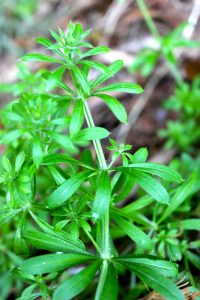
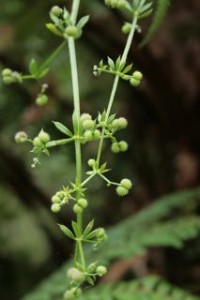
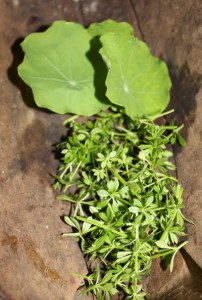
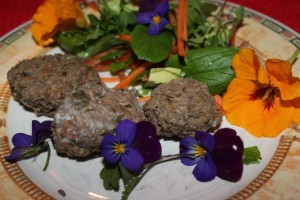
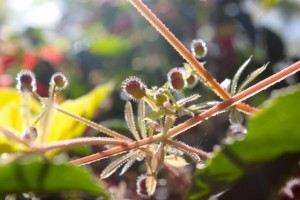
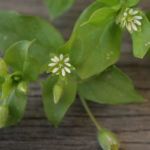
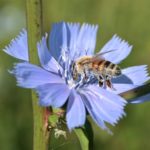
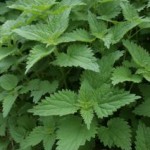
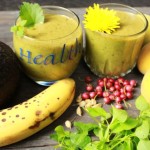
Hi Julia, how timely this post is. I have been looking for some savory snacks and here you are with your marvelous healthy meat balls. I will make them small so I can just take one when I feel like one. I have gone out to look for cleavers, just like an easter egg treasure hunt and I did find some. So I will know what I am doing tomorrow. Thanks again for a great post and the photo of your colorful salad is delightful, who would have thought weeds can be so beautiful?
HI Wilma, I love the image of your going out for an Easter Egg hunt to find cleavers!! The meatballs are a great snack and they freeze really well. I make a big batch eat some for breakfast and freeze some – and what I love is that they hold together so well without flour or egg or anything just meat and vegetables. I keep a lid on the pan when I cook them as the water comes out of them and they shrink, then they cook in the liquid and you have to watch that they don’t dry out and get over cooked. I’m getting the hang of making them now. Have fun! Thank you for writing – weeds are so beautiful. My interest and love for them keeps growing!
I just wanted to comment about my experience with cleavers. Up until about 8 years ago I would get the flu every winter; it would follow the same pattern and the full course would last about 2 weeks. Then some naturopath friends told me about cleavers. One said to make tea with the leaves, the other said to take 25-30 tips (about 8 cm) and soak in cold water over night, then drink in the morning. I chose to do that, and have never had the flu again. And it is a delicious drink to begin the day.
Love reading your column – thank you!
HI Flynn,
that is fantastic feedback – thank you so much for writing to tell me!! It is such a good cleanser and obviously helped you cleanse and then not need to get the flu!! May I share your experience with others? It would be something very inspiring for people to hear.
Thank you also for the great feedback about the column!